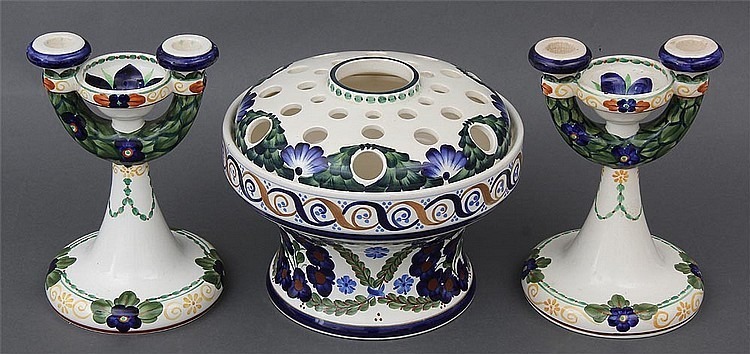The Faience Manufacturing Company was an American manufacturing company that operated between 1880 – 1892 in the Greenpoint area of Brooklyn, New York. There is little evidence of the remains of the Company as it failed in 1892.
Short History
It manufactured earthenware vases, jardiniéres, and baskets at first. British émigré, Edward Lycett was the artistic director and supervised 25 decorators. He experimented with a fine grade of white porcelain and produced the metallic glazes of Persian lusterware. Lycett worked with American retailers nationwide, including Tiffany & Company. He specialised in bulbous vases and ewers with Moorish filigree lids, dolphin handles, gilded spider-web textures and Japanese chrysanthemum motifs.
Edward Lycett – Director
Edward Lycett’s success in the US was fueled by his artistic talent and business acumen, which resulted in a White House commission and recognition from Edwin Atlee Barber. During the 1870s, Lycett made the most of amateur china painting by firing pieces created by female artists.
Together with John Bennett, he co-founded the Faience Manufacturing Company, where he later rose to the position of art director. He experimented with various clay bodies and glazes and created unique ceramic forms.
The products of The Faience Manufacturing Company are bold and opulent in decoration and display a self-aware boldness that draws inspiration from fashionable English and European goods as well as ancient, mediaeval, and Renaissance objects. Due to financial issues, the Faience Manufacturing Company ceased making pottery, and Lycett retired and relocated to Atlanta, Georgia, where he resided with his son William. Edward Lycett’s successful career spanned more than fifty years thanks to a special combination of artistic talent, self-promotion, and opportunity capitalisation. (Veith, 2012)
Selection of their work





Sources
Byars, M., & Riley, T. (2004). The Design Encyclopedia. Laurence King Publishing. https://amzn.to/3ElmSlL
Veith, A. B. (n.d.). Edward Lycett (1833–1910) | Essay | the Metropolitan Museum of Art | Heilbrunn Timeline of Art History. The Met’s Heilbrunn Timeline of Art History. Retrieved March 30, 2023, from https://www.metmuseum.org/toah/hd/lyce/hd_lyce.htm
You may also be interested in
Ceramics a gift from the ancients – Encyclopedia of Design
Ceramics are objects made of moistened clay, shaped and then baked. All ceramics are Earthenware, terracotta, brick, tile, faience, majolica, stoneware, and porcelain. Ceramicware is decorated with clay inlays, relief patterns on the surface, or incised, stamped or embossed designs. For coating, the ware, a creamy mixture of clay and water (slip) can be used.
Dorothy Draper American interior designer – Encyclopedia of Design
Dorothy Draper (1889 – 1969) was an American interior designer. She was born in Tuxedo Park, New York. Draper’s upper-crust upbringing, Tuxedo Park was one of the first gated communities in the United States. Dorothy’s parents were part of an old New England family with longstanding social connections.